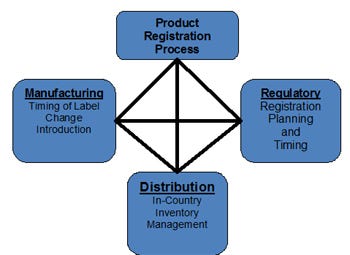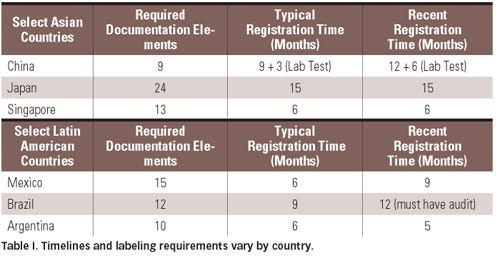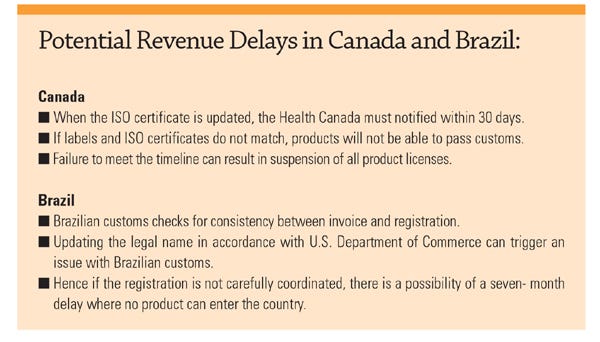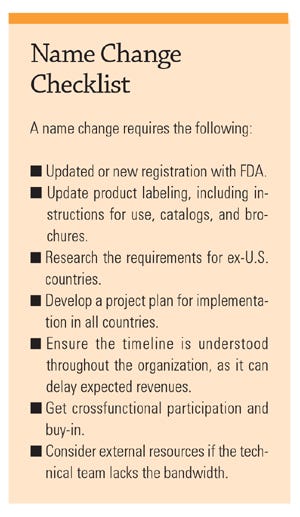Too often medical device manufacturers overlook what changing product names or ownership truly involves.
Consider these common scenarios: an acquisition or carve-out occurs, and a medical device has a new manufacturer, or a manufacturer decides to change its name as a result of restructuring. Both occurrences are common in today’s rapidly changing business environment. After the dust settles on a name change, it’s often up to company executives to complete the implementation plan and move the new business forward, often with little time or often with fewer resources. However, a manufacturer change or product name change requires modifications to the product labeling and regulatory reregistrations, which are increasingly complex. This article covers key steps required for successful reregistration and labeling changes while presenting strategies to avoid common pitfalls.
|
Name Change Requirements
Most developed countries require a device to be registered, clearly displaying the legal manufacturer’s name. Abroad, outside the European Union (EU) and United States, about 40% of countries require a CE certificate to register the product. Roughly 20% of these countries require a certificate to foreign government (CFG) or certificate of free sale from the country of manufacture in order to register the product. In the event of a company name change in the United States, FDA requires an update to the registration per 21 CFR 807.26 and 21 CFR 807.30. In the event of a name change for devices sold in the EU, an updated CE certificate is required. All countries that have regulations concerning the marketing of medical devices require some sort of notification in the event of a company name change, which can range from a simple notification to a full reregistration.
Product Labeling
A changed company name also triggers the need to update the product labeling. In the United States, FDA requires registration within 30 days of commercial distribution of the device per 21 CFR 807. FDA 21 CFR 801 requires the name of the manufacturer to be conspicuously displayed on the product labeling. For product sold in the EU, the label must bear the name or trade name and address of the manufacturer per MDD 93/42/EEC Annex 1, 13.3. This requirement applies to all countries that have regulations concerning medical devices.
Product labeling is a broad category covering areas including the actual product label, instructions for use, product inserts, packaging, and collateral such as brochures, catalogs, and other promotional vehicles.
FDA does not require updated labeling to be submitted in order to change the company name, but clearly expects that the company will be making a good faith effort to update the label copy in a timely manner.
Requirements Beyond U.S. Borders
For products sold to international markets, the requirements for each country must be researched and understood. In order to export the product, correct labeling and FDA registration is needed to obtain Certificates to Foreign Government (CFG).
While no blanket rules apply to requirements for all export countries, all countries require the label to match what is listed in the registration. For example, in the EU, the manufacturer information on the label must match the manufacturer information listed on the CE certificate and the Declaration of Conformity.
Outside of the EU, it’s not uncommon for CE and ISO certificates to be required as supporting documentation for registration. Each country has its own requirements, so it’s necessary to develop an individualized approach to gathering requirements and developing an implementation plan (see Table I).
|
Risks and Pitfalls: Revenue Delays
During the merger or acquisition process, the deal makers might not fully appreciate the reregistration workload or timeframe. This task typically falls upon technical executives after the deal is signed. All too often, the acquiring firm has limited technical staff and a narrow bandwidth to take on such extensive research let alone the implementation in every country, and this often results in revenue delays. The technical executives must deliver the message about these delays to the management team, who made the deal expecting they were buying an established revenue stream from the legacy product.
One remedy for delayed revenues is to outsource the product reregistration process. Compliance consultants typically know the county-by-country requirements, which can help to eliminate the delays (see the sidebar “Potential Revenue Delays in Canada and Brazil”). Ideally, the compliance consultants would be brought into the acquisition process during the due diligence stage. This introduction helps the acquiring firm anticipate revenue delays, quantify the reregistration costs, and identify any gaps in testing or technical data, which can be factored into the deal price and/or the posttransition agreements. For example, the postdeal transition agreement might require the seller to continue manufacturing the product until the buyer can reregister the product.
|
Crossfunctional Complexities Behind Reregistrations
The reasons that drive product reregistrations are oftentimes fraught with crossfunctional complexity. So while the technical team is reregistering the product and introducing new labeling into multiple manufacturing plants, they’re also responsible for complex tasks resulting from the acquisition. This process could include transferring production, which will trigger reregistration in most countries, managing inventory across multiple country locations, and coordinating product with multiple distributors in various countries. It all takes place while the technical executives must remain focused on their primary job functions such as getting product out the door for sale to customers.
|
Manufacturing Transfer
Oftentimes the manufacturing location changes as part of the merger or acquisition. Acquiring firms may see value in aggregating plants or in transferring production. The resulting changes in manufacturing location must be included in the registration process.
The added registration complexities of changing location fall upon the shoulders of technical executives who have full plates with shutting down the old facilities while bringing new facilities onboard. In addition, they have the challenge of introducing new labeling into the manufacturing process, and a change in location can be a trigger for facility inspections in many countries.
Distribution Challenges
Introduction of new product and obsolescence of the old product requires coordination across manufacturing and distribution sites for each country. For countries with a long reregistration process, it means old product needs to be reserved. Other countries, such as Spain, will allow a mixture of old and new product to be imported but will fine the company for sending the old product after they start receiving the new product. For some manufacturers with multiple distributors in each export country, the coordination is very complex and falls upon technical personnel already engaged in other aspects of the merger or acquisition.
Some countries allow for a transfer of registration between distributors with a short approval time, however other countries require new or reregistration when a distributor is changed as the distributor or in country representative is the owner of the registration.
Planning is Everything
A clearly laid-out plan that coordinates the registration with the labeling revision process and any potential manufacturing site changes is essential to ensure continued market access and channel inventory for the product. The plan provides visibility for introducing the newly labeled product into the various U.S. and export markets.
Conclusion
Changes to the company name require modifications to the labeling and reregistration of the product in every country of distribution. It requires a well-researched project plan that addresses the requirements of each country and coordinates crossfunctional activities across the company. Given the complexity of determining and implementing the plan, experts recommend that companies determine the costs and potential revenue delays before embarking upon a name change. In the case of mergers or acquisitions, it’s important that technical executives are part of the due diligence team so these costs and revenue delays can be factored into the deal price. When the technical executives are stretched thin between doing their day jobs and handling the reregistration, expert consultants can help quantify these costs and delays and are available to help implement the plan after the deal closes.
| Chris Henza is a regulatory affairs specialist with Regulatory Compliance Associates Inc. Henza has been the interface with regulatory authorities for small and large companies on domestic and international product registration, production changes, design changes, and documentation remediation. Henza also wrote "Reforming the 510(k) Process: Where We Are, How We Got Here, and What's to Come". She graduated from Northeastern Illinois University with a BS in Biology and can be reached at [email protected] |
| Nicohl Wilding is a senior auditor and regulatory SME for Regulatory Compliance Associates. Wilding has more than 14 years’ experience in the medical device and pharmaceutical industry incorporating all aspects of drug and device development including clinical research, data management, regulatory affairs, and quality system implementation and management. She has written and managed numerous submissions to U.S. and international regulatory agencies, and developed global regulatory strategies for medical devices. She graduated with a BS degree from the University of Illinois, Chicago and can be reached at [email protected]. |
Portions of this article are copyrighted by Regulatory Compliance Associates Inc. and have been printed with permission. |
About the Author(s)
You May Also Like








